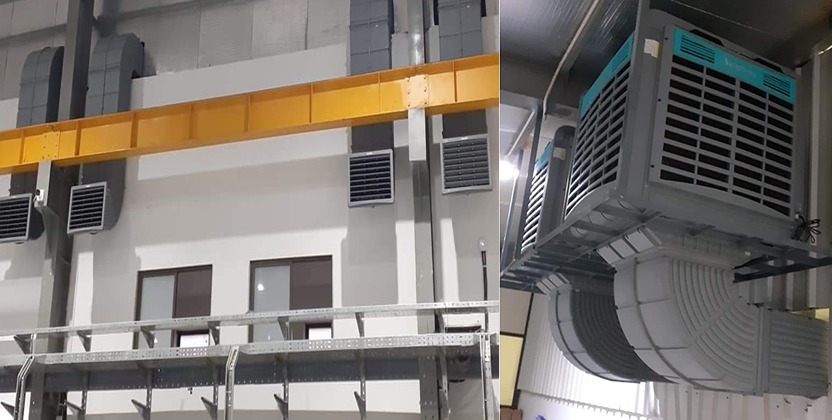How Policy Changes Can Improve Workplace Temperature Regulations in India?

Workplace temperature regulation is a critical aspect of occupational health and safety, yet India lacks clear and enforceable guidelines on this issue. With industrial workplaces experiencing temperatures of 40°C to 45°C, heat stress has become a major concern for worker productivity, safety, and well-being.
Unlike developed nations, India does not mandate specific temperature standards for workplaces. The Workmen Regulations Act, 1923, mentions ceiling fans and exhaust fans but fails to address modern workplace cooling solutions. This regulatory gap leaves millions of workers exposed to extreme temperatures, affecting productivity and increasing the risk of heat-related illnesses.
This article explores the urgent need for policy changes, the impact of heat stress on Indian workers, and the measures other countries have taken to ensure safer working conditions.

The Impact of Heat Stress on Indian Workplaces
1. Productivity Decline Due to High Temperatures
Studies, including research conducted by IIM Ahmedabad, reveal that temperatures above 24°C negatively affect worker productivity and accuracy. When temperatures rise to 38°C or higher, productivity losses can reach 62%, while errors increase dramatically.
A study by NASA also confirms that as workplace temperatures rise:
- Accuracy drops by over 700% at 41°C
- Cognitive functions decline significantly
- Reaction times slow, increasing accident risks
2. Heat-Related Health Risks in Industrial Sectors
Many industries, such as textiles, steel, manufacturing, and construction, expose workers to extreme heat. Studies indicate that heat stress leads to:
- Dehydration and exhaustion
- Reduced cognitive function and slower reaction times
- Increased risk of heatstroke and cardiovascular stress
A 2016 study found that 87% of industrial workers reported health issues due to heat exposure, with nearly half experiencing productivity declines.
3. Rising Absenteeism and Workplace Accidents
Unregulated workplace temperatures contribute to higher absenteeism rates and frequent accidents. Heat stress can impair judgment and increase fatigue, leading to injuries and lower workplace morale.
Industries without cooling regulations face higher attrition rates, as workers seek employment in more comfortable environments.
How India’s Workplace Temperature Regulations Compare Globally?
Several countries have already implemented strict policies to regulate workplace temperatures:
South Korea
- Mandates a maximum workplace temperature of 24°C for indoor workspaces.
- Employers must provide cooling solutions and hydration stations.
European Union
- The EU Workplace Directive mandates that employers ensure comfortable thermal conditions.
- Germany enforces temperature regulations for both offices and industrial settings.
United States
- The Occupational Safety and Health Administration (OSHA) issues guidelines for preventing heat-related workplace illnesses
Despite these advancements, India has no mandatory workplace temperature standards. The Workmen Regulations Act, 1923, remains outdated, failing to recognize the needs of modern industrial environments.
How Can Policy Reforms Improve Workplace Temperature Regulations in India?
1. Setting a Legal Maximum Workplace Temperature
- India should follow global standards and establish a maximum indoor workplace temperature of 24°C to 30°C.
- Factories, warehouses, and industrial plants must have mandatory air cooling systems.
2. Making Industrial Air Cooling Mandatory
Air cooling is more energy-efficient and cost-effective than air conditioning.- Air coolers are environmentally friendly and reduce heat stress.
- Unlike air conditioners, they circulate fresh, moist air, preventing dehydration.
3. Implementing Regular Heat Stress Assessments
- Employers should monitor workplace temperatures and implement cooling solutions when necessary.
- Periodic inspections should ensure compliance with workplace safety standards.
4. Employee Education and Training on Heat Stress
- Training programs should educate workers on recognizing heat stress symptoms.
- Employers must provide hydration stations and encourage frequent breaks in high-temperature environments.
5. Tax Incentives for Employers Who Invest in Cooling Solutions
- The government should offer tax breaks to industries that install industrial air cooling systems.
- Encouraging businesses to adopt sustainable cooling measures will benefit both workers and productivity.
Key Takeaways
- India lacks clear regulations on workplace temperature control, leaving workers vulnerable to heat stress.
- Productivity declines sharply when workplace temperatures exceed 24°C, with accuracy losses reaching 700% at 41°C.
- Countries like South Korea, the EU, and the U.S. have implemented strict workplace temperature policies.
- Industrial air cooling is a cost-effective, eco-friendly alternative to air conditioning, improving worker comfort and efficiency.
- Introducing legal temperature limits, mandatory cooling, and tax incentives can drive regulatory changes in India.
FAQs on Air Cooling System
India experiences extreme heat in industrial sectors. Unregulated temperatures reduce productivity, increase health risks, and raise absenteeism rates.
Research suggests that the ideal workplace temperature is between 20°C to 24°C. Productivity and accuracy decline significantly beyond 26°C.
Employers should:
- Install industrial air cooling systems
- Improve workplace ventilation
- Provide hydration stations and cooling breaks
Workers exposed to high temperatures face:
- Dehydration and heat exhaustion
- Cognitive impairments, leading to more errors and accidents
- Increased risk of heatstroke and cardiovascular problems
- Amend the Workmen Regulations Act, 1923, to include mandatory cooling solutions.
- Set legal temperature limits for industrial workplaces.
- Introduce tax benefits for industries investing in air cooling systems.
Conclusion
The absence of workplace temperature regulations in India is a serious occupational hazard. Studies show that excessive heat reduces productivity, increases absenteeism, and raises accident risks. While developed countries have enacted strict temperature controls, India’s outdated policies fail to protect workers.
Implementing mandatory cooling solutions, legal temperature limits, and employer incentives can significantly improve worker safety and industrial productivity. The time for policy changes is now—India must act to ensure a safer, more efficient workforce.


